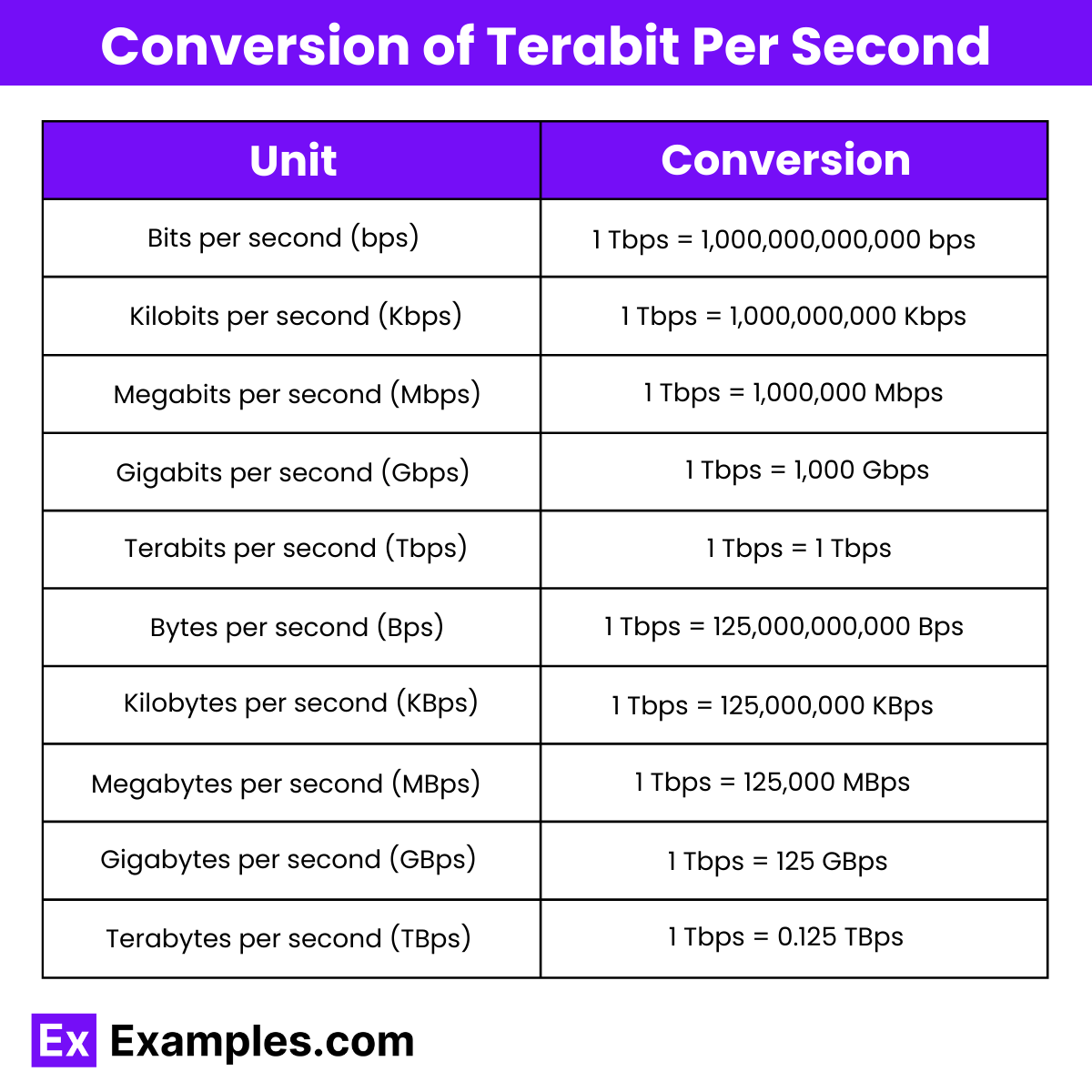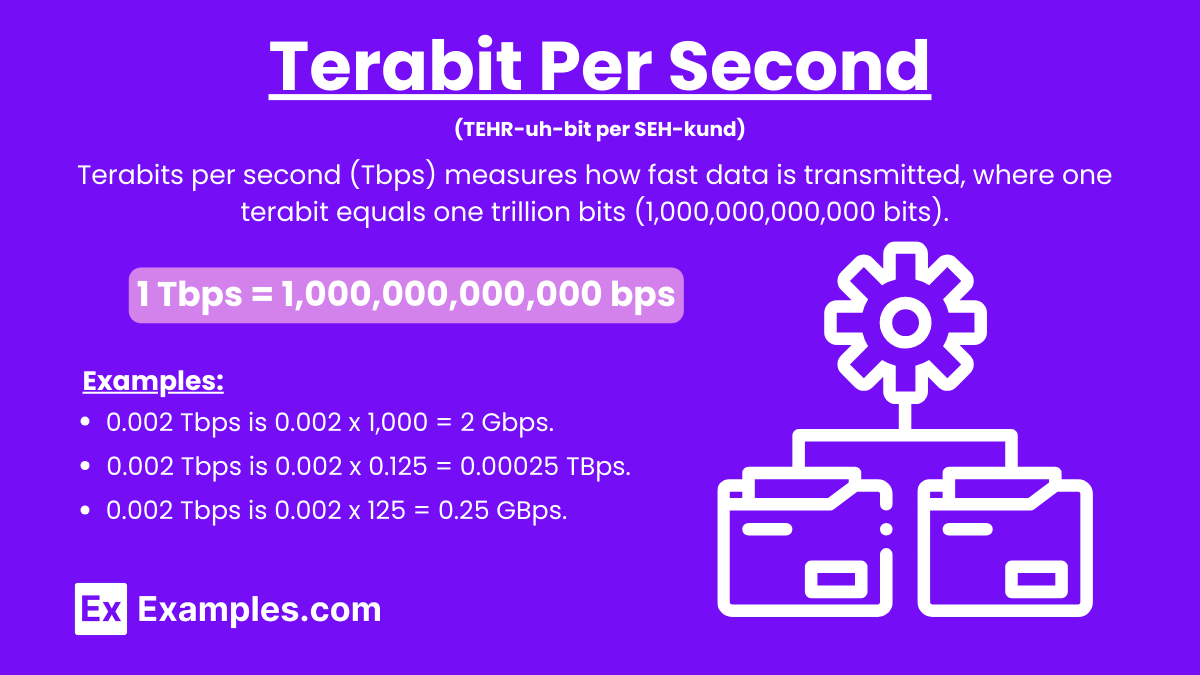Terabit Per Second – 15+ Examples, Formula, Conversion Chart, Uses
Terabit per second (Tbps) is a unit of data transfer rate used to measure the speed at which data is transmitted over a network or a communication channel. It represents the amount of data that can be transferred per second, with 1 Tbps equaling one trillion bits per second. In different contexts, other units of speed are used, such as foot per second, meter per second, and miles per second, to measure the velocity of objects. Each of these units provides a specific way to understand the rate at which something moves over a given second, whether it’s data through a network or physical objects in motion.
What is Terabit Per Second?
Terabits per second (Tbps) measures how fast data is transmitted, where one terabit equals one trillion bits (1,000,000,000,000 bits). This unit is often used to describe data transfer speeds in high-capacity networks and communication systems. Higher Tbps values indicate faster data transmission, which is crucial for efficiently handling large volumes of data in applications such as internet backbone networks, data centers, and cloud services. Understanding units of measurement is essential in various fields, including data transfer rates. Different measurement units are used to quantify speed and length, such as meters or feet. A measurement chart can help convert between these units, ensuring accuracy and clarity in communication.
Examples of Terabit Per Second
- Data center interconnect
- High-frequency trading networks
- Large-scale cloud computing services
- Intercontinental submarine cables
- Global content delivery networks (CDNs)
- Supercomputing data transfers
- Telecommunications backbone infrastructure
- 5G network backhaul
- Broadcasting ultra-high-definition (UHD) video
- Real-time big data analytics
- Virtual reality streaming services
- Artificial intelligence model training
- Satellite communication networks
- Government and defense secure communications
- Large-scale scientific research data transfer (e.g., CERN)
Terabit Per Second Formula
The formula to calculate the data transfer rate in terabits per second (Tbps) is:
Data Transfer Rate (Tbps) = Time Taken (Seconds)/Total Data Transferred (Terabits)
Steps to Use the Formula
- Determine the Total Data Transferred
- Measure the total amount of data transferred.
- Convert this amount to terabits (Tb). If the data is in bits, divide the total number of bits by 1,000,000,000,000 to get terabits.
- Measure the Time Taken
- Measure the total time taken for the data transfer in seconds.
- Apply the Formula
- Divide the total data transferred (in terabits) by the time taken (in seconds) to get the data transfer rate in terabits per second (Tbps).
Conversion of Terabit Per Second

| Unit | Conversion |
|---|---|
| Bits per second (bps) | 1 Tbps = 1,000,000,000,000 bps |
| Kilobits per second (Kbps) | 1 Tbps = 1,000,000,000 Kbps |
| Megabits per second (Mbps) | 1 Tbps = 1,000,000 Mbps |
| Gigabits per second (Gbps) | 1 Tbps = 1,000 Gbps |
| Terabits per second (Tbps) | 1 Tbps = 1 Tbps |
| Bytes per second (Bps) | 1 Tbps = 125,000,000,000 Bps |
| Kilobytes per second (KBps) | 1 Tbps = 125,000,000 KBps |
| Megabytes per second (MBps) | 1 Tbps = 125,000 MBps |
| Gigabytes per second (GBps) | 1 Tbps = 125 GBps |
| Terabytes per second (TBps) | 1 Tbps = 0.125 TBps |
Understanding how to convert data transfer rates to other common units is essential when managing different data speeds. This skill is crucial for configuring network settings, comparing internet speeds, and ensuring accurate data rates for projects. Here’s a straightforward guide to converting data transfer rates to and from other common units:
Terabits per second (Tbps) to Bits per second (bps)
Multiply the Tbps value by 1,000,000,000,000 to convert to Bits per second.
Example: 0.002 Tbps is 0.002 x 1,000,000,000,000 = 2,000,000,000 bps.
Terabits per second (Tbps) to Kilobits per second (Kbps)
Multiply the Tbps value by 1,000,000,000 to convert to Kilobits per second.
Example: 0.002 Tbps is 0.002 x 1,000,000,000 = 2,000,000 Kbps.
Terabits per second (Tbps) to Megabits per second (Mbps)
Multiply the Tbps value by 1,000,000 to convert to Megabits per second.
Example: 0.002 Tbps is 0.002 x 1,000,000 = 2,000 Mbps.
Terabits per second (Tbps) to Gigabits per second (Gbps)
Multiply the Tbps value by 1,000 to convert to Gigabits per second.
Example: 0.002 Tbps is 0.002 x 1,000 = 2 Gbps.
Terabits per second (Tbps) to Bytes per second (Bps)
Multiply the Tbps value by 125,000,000,000 to convert to Bytes per second.
Example: 0.002 Tbps is 0.002 x 125,000,000,000 = 250,000,000 Bps.
Terabits per second (Tbps) to Kilobytes per second (KBps)
Multiply the Tbps value by 125,000,000 to convert to Kilobytes per second.
Example: 0.002 Tbps is 0.002 x 125,000,000 = 250,000 KBps.
Terabits per second (Tbps) to Megabytes per second (MBps)
Multiply the Tbps value by 125,000 to convert to Megabytes per second.
Example: 0.002 Tbps is 0.002 x 125,000 = 250 MBps.
Terabits per second (Tbps) to Gigabytes per second (GBps)
Multiply the Tbps value by 125 to convert to Gigabytes per second.
Example: 0.002 Tbps is 0.002 x 125 = 0.25 GBps.
Terabits per second (Tbps) to Terabytes per second (TBps)
Multiply the Tbps value by 0.125 to convert to Terabytes per second.
Example: 0.002 Tbps is 0.002 x 0.125 = 0.00025 TBps.
Importance of Terabit Per Second
Just as KBps is used to measure data transfer rates, other units of measurement like yard, centimeter, and millimeter are used to quantify length in various contexts. Using a measurement chart helps convert between these units, providing clarity and precision in different fields of study and application.
- Scalability and Future-Proofing: Prepares infrastructure for future data demands, ensuring long-term relevance.
- Competitive Advantage: Provides a significant edge by delivering faster and more reliable services.
- Enhanced User Experience: Reduces buffering and loading times, leading to higher user satisfaction.
- Efficient Data Center Operations: Boosts the efficiency and speed of data handling in large-scale computing environments.
- Supporting Technological Innovations: Drives advancements in networking, storage, and computing technologies.
Where do you use of Terabit Per Second
- Internet Backbone Infrastructure: The core networks that form the backbone of the internet use Tbps to measure data transfer rates. These high-capacity links are essential for handling the vast amount of data traffic across global networks, ensuring fast and reliable internet connectivity.
- Data Centers: Large-scale data centers use Tbps to manage data transfer rates between servers, storage systems, and network infrastructure. High-speed interconnections in Tbps are crucial for maintaining performance and efficiency in handling massive volumes of data.
- Cloud Computing: Cloud service providers use Tbps to measure and advertise data transfer rates for their services. This includes data transfer within and between data centers, ensuring high performance for cloud-based applications, storage, and processing.
- High-Performance Computing (HPC): HPC environments, such as supercomputers used for scientific simulations, data analysis, and complex computations, rely on Tbps to measure data transfer rates. High-speed data transfer is essential for efficient processing and handling of large datasets.
- Telecommunication Networks: Advanced telecommunication networks, including 5G infrastructure and beyond, use Tbps to measure data transfer rates. This ensures ultra-fast data transmission, supporting a wide range of applications from mobile broadband to industrial IoT.
- Content Delivery Networks (CDNs): CDNs that distribute large volumes of digital content, such as streaming video, software downloads, and online gaming updates, use Tbps to measure data transfer rates. High-speed delivery is essential for providing a seamless user experience.
- Intercontinental Communication: Undersea fiber-optic cables that connect continents use Tbps to measure data transfer rates. These high-capacity links are critical for international data transmission, supporting global communication and commerce.
What technology supports Tbps speeds?
Advanced fiber optic technology and next-generation networking hardware support Tbps speeds.
Can home internet reach Tbps speeds?
Currently, home internet does not reach Tbps speeds; it is primarily used in specialized high-speed networks.
How does Tbps benefit data centers?
Tbps enables faster data processing and transfer, improving efficiency and performance in data centers.
Is Tbps speed achievable with current technology?
Yes, Tbps speeds are achievable with advanced fiber optics and state-of-the-art networking equipment.
What industries benefit from Tbps speeds?
Industries like telecommunications, cloud computing, and scientific research benefit from Tbps speeds.
How does Tbps impact streaming services?
Tbps improves streaming quality and reduces latency, allowing seamless delivery of high-definition content.
What is the future of Tbps technology?
The future of Tbps technology includes further advancements in fiber optics and increased accessibility for various sectors.
How does Tbps enhance internet backbone networks?
Tbps enhances internet backbone networks by providing higher data capacity and reducing congestion.
Can Tbps handle real-time data applications?
Yes, Tbps can handle real-time data applications, such as live video streaming and online gaming.
What challenges exist in implementing Tbps networks?
Challenges include high costs, technological limitations, and the need for advanced infrastructure.


